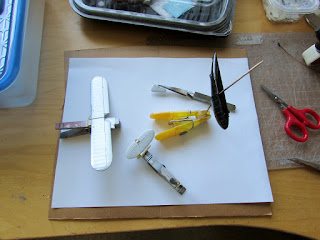The Short Brothers S.1 Cockle (first named Stellite) was a
one-off endeavor commissioned privately. First flying in 1924 it shows another
effort by Short to master the intricacies of metal airplane building (seen also
in the S.4 Satellite), having an aluminium hull and frame.
The very small twin engine arrangement reminded of a scratch
I did time ago, the Gnosspelius Gull, and what do you know, Mr. Gnosspelius was
indeed attached to this project as I found out doing some research for this build.
The prototype had some difficulty trying to separate itself
from the water, and being marginally powered -to put it mildly- it was no
surprise, but finally achieved flight by making some changes to the airframe.
The original tail was later replaced by a larger and differently shaped one. The Cockle ended up being used for some trials and experiments (The kit has both
tails for you to chose from).
Instructions tell you to paint the hull bottom and wing
floats black, which is not unusual, but at least one clear photo shows the
plane with no color whatsoever on those areas, having the hue of the rest of
the plane, aluminium. A very unreliable small card drawing with the wrong
registration found on the net shows those areas on red. The choice is yours.
With all the recent Avis releases I am (flying) in heaven. Still for me to get is their newly issued civil Bristol M1D.
And now, the matter at hand:
Two horizontal and two vertical tails are offered:
The surface detail is convincing:
Even the minuscule Blackburne Tomtit engines are rather convincing for this scale:
Decals for the two versions and the usual Avis film windshields:
Main parts separated and cleaned up, you can see that there is some detail in the cockpit area>
The engine fairings have nice detail, but this (fuel/oil caps) I will obliterate for the moment to be able to clean the seam. Later on punched out parts will be made:As said, nice detail, where other manufacturers give you just a plain volume:
Built already:
Cockpit assembly and the rest of the useful bits. The engine cylinders even have minuscule cooling fins. I love this one:
The rest dozen or so parts. I per norm shun all "rod" and "strut" parts form the kits, since precious time is wasted in cleaning them to only obtain a so-so, uneven shape of generally dubious cross-section, and instead use styrene or metal rod, stretched sprue and strut material. The exception may be those L and V small parts that hold the wing, we'll see. By the way, the kit doesn't provide the lower horizontal tail struts, same as with the Satellite, and you have to make them (which is no big deal, whatsoever):
Preparing a painting session:
Look at that beautiful speckle of a Blackburne Tomtit engine! (still to paint some detail):
The engine pods and wing floats ready to paint now (I already added the new fuel caps, removed during sanding):
More painting ensues:
The inst. pan. and cockpit pan are fixed in place and the fuselage halves are united:
Some additional painting goes on:
The location for the beaching wheels, which is clearly marked, is drilled through to later install an axle instead of two halves of an axle. The fit of the fuselage halves was very good, all panel lines exactly coinciding -something you don't see every day-, but I am fixing a hairline gap on the nose:
The same holes will help to hold it while priming:
This time I will use gloss white as a base for the Alclad aluminium, to get a lighter tone. The fuselage is primed, the accessories are ready:
The primer revealed a few spots that needed attention, and I took advantage to replace a very small fin near the tailcone that was obliterated during building. The Flight magazine article states that the beaching wheels could be carried inside the plane if wanted, to be used to beach the plane upon destination. That's a strange statement, since the cockpit opening is much smaller than the wheels, and I can't see any hatches (doesn't mean it didn't have them, though):
The flying surfaces are painted, and the fuselage is given a coat of Alclad gloss black base:
The hue differences between metal and doped fabric can be seen now:
The kit's Pitot is quite good, but I made one from scratch:
The vertical tail is inserted onto the horizontal tail (leave a gap, the original had it) and then inserted in the holes on the fuselage. The engine fairings are glued in place:
Engines and axles are glued in place:
The wing floats are being prepared. I am adding these elements on the wing now, contrary to what seems (and usually is) practical, because the wing is held in place by fragile connecting elements, thus not very happy to take loads later on:
While the leading edge of the wing is propped up, the back of the wing was somehow rounded -or slightly supplemented- to follow the curve of the fuselage spine:
The wing is glued on, and all struts, for wing and tail, are replaced with Strutz (thanks Andrew and John!):
Photos show rigging between fin and stab, and control cables going top the horns, above and below the elevators, so those are added:
The big registrations on the wing are separated in two blocks on the sheet, still, there is a lot of carrier that I wanted to reduce, so I cut the individual letters appart:
The instructions are inaccurate regarding the placement of the regs under the wing; as photos show the letters are inside the float, not starting outside it, this is how they should be:
To be continued.....











































No comments:
Post a Comment